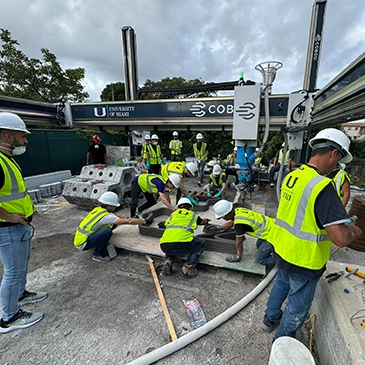Topic: Science and Technology
Before flowers, ancient plants used heat to attract pollinators
A team of researchers has made new discoveries about the origins of pollination and plant-animal communication.
Exploring new chemistry for cleaner water
University of Miami engineering professor Virender Sharma uncovers how iron-based reactions can make water treatment more efficient.
From freezing University of Miami labs to IBM’s quantum frontier
Physics alumna Daniela Bogorin brought her expertise to IBM, where she tests next-generation quantum computers.
2025 Hurricane Season Wrap Up
The 2025 Atlantic hurricane season marked the first time in 10 years that no hurricane made a U.S. landfall—just one of the oddities of a season that started quietly and ended with the devastation of Hurricane Melissa
Students bring stories to life through Telemundo partnership
A new program at the School of Communication is giving students hands-on experience developing and producing podcasts that will be published by Telemundo Studios.
Rocket Canes soar to new heights
The student-run Rocket Canes club at the University of Miami allows engineering students the chance to design, build, and launch rockets—turning classroom concepts into real-world experience.
Are students too connected to disconnect?
Constant screen exposure is leaving students drained, distracted, and detached. University experts warn that too much time online can quietly damage focus and mood but say it is never too late to reset.
Computing for Resilience
The 2025 Acadia Conference convened researchers, practitioners, and students at the University of Miami and Florida International University to examine how computational tools are reshaping the future of the built environment.
Pushing the boundaries of human performance
New master's program blends engineering principles and kinesiology to prepare students for the unique opportunities in sports technology and equipment design.
Pushing the boundaries of human performance
New master's program blends engineering principles and kinesiology to prepare students for the unique opportunities in sports technology and equipment design.
CAST researchers earn honors at annual aerosol research meeting
The Center for Aerosol Science and Technology (CAST) had a strong presence at the 2025 annual meeting of the American Association for Aerosol Research in Buffalo, New York, with faculty, postdoctoral researchers and Ph.D. students delivering 18 presentations and earning multiple awards.
Harnessing the power of the sun to ‘change the world’
A University of Miami College of Engineering researcher is tackling one of fusion energy’s toughest challenges: finding metals that can withstand the extreme conditions inside future commercial fusion reactors.























